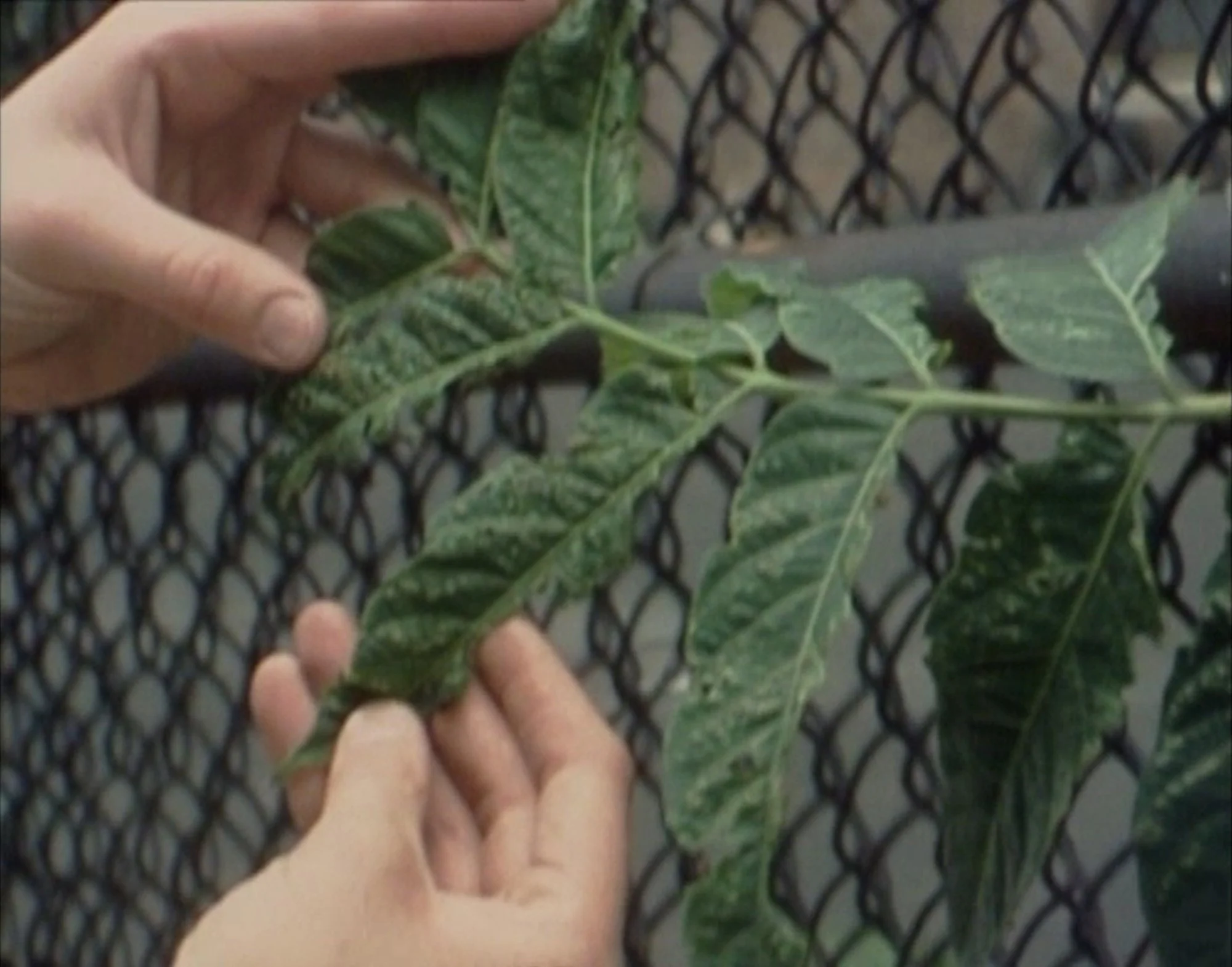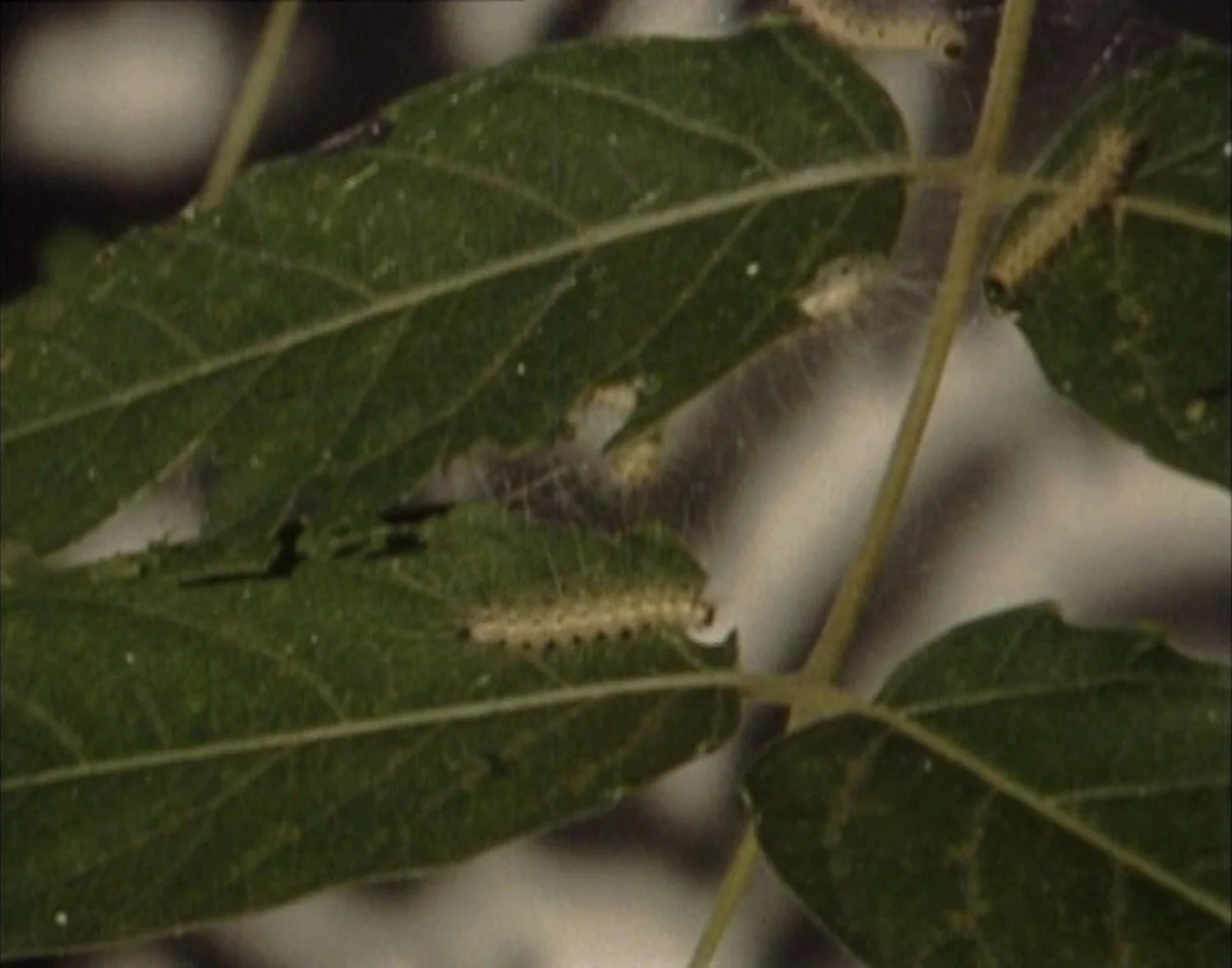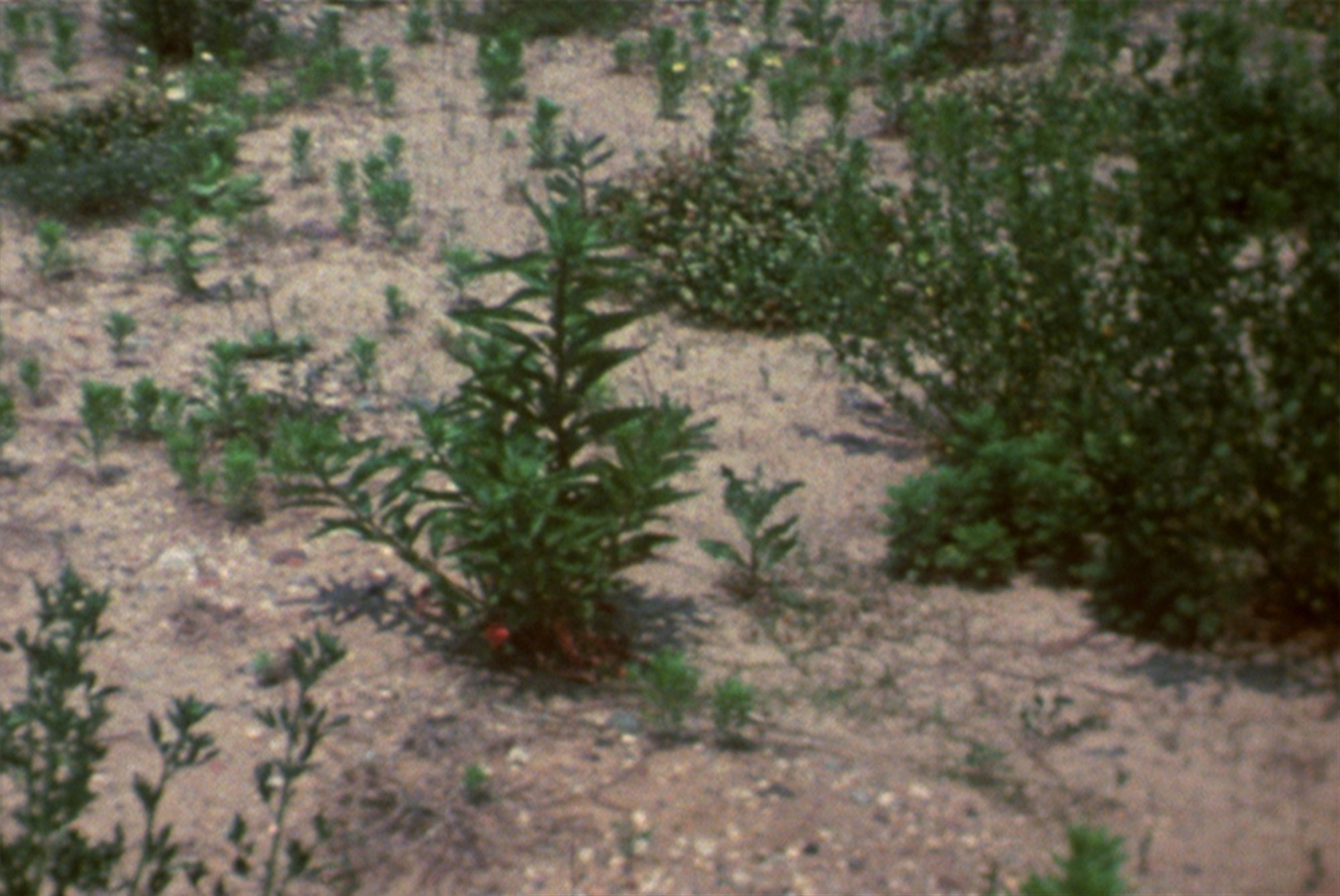THE INSISTENCE OF WEEDS

The present demands a reconstruction of narration. I can feel this every time I search for contradiction, when I yearn for the condition around me to expose a secret property, something which can distort my perception of reality. It is a hunger I often satisfy through pseudoscientific podcasts or fringe theories, and something I constantly look for in contemporary art. I want a false protagonist of my focal point to be undressed, killed or eradicated before me in order to reorient my tiresome subjectivity – my struggle against feeling blasé or overtly submerged in SOCIETY. I arrive at SixtyEight Art Institute somewhat with prejudice, the title ”Ruderal Futures” feels either desperate, utopian or too posthumanist (for my taste). I kind of hope for the first one but would probably enjoy a mixture.
“Struggle is the enemy
But weed is the remedy”
– Kid Cudi
I encounter an exhibition presenting works by seven artist-researchers, who in their own way present and investigate ecological futurities that are emerging under, beside, slightly above, just next to or in the cracks of the mainstream conception of nature, defined as a time-based phenomenon currently being delivered by capitalism and colonialism.
The exhibition imagines how nature can grow, thrive, morph, malform or adapt out of ruins, altered land and deserted cities. Which plants and ruderal species would make up the new flora, and how would they interact and coexist next to each other? The exhibition tries to escape any simple dichotomy between useful species and ambiguous weeds, to move beyond politics of elevation or eradication.
Ruderal Futures. SixtyEight Art Institute, 2022. Photo: Jenny Sundby.
SixtyEight Art Institute writes: “[the artists’] contributions evoke plausible worlds of nonhierarchical kinship from the aftermath of both historic and ongoing colonial violence and capitalist anthropogenic land use”, and I perceive this as a statement in line with current trends in ecological thinking: a temporary abandonment of the present to imagine futurities that further sediment us in the contemporary – if that makes sense? I think of their proposition as an acute re-evaluation of the temporary classification into plants and weeds, based on the notion that at some time in the future invasive species and unwanted weeds COULD potentially help or heal ecological and societal degradation. It is therefore important to encounter this exhibition as a proposition for how to rethink imagery of the apocalyptic destruction of nature and the concept of survival. It tells us to not panic, the future will remain organic – just slightly altered regarding species.
Lindsey french, discreet broadcasts for Lysichiton americanus, 2022 (Indole, alcohol, aloe, hydrogen peroxide, sanitizer dispenser; solar-powered radio transmitter, recorded audio). Photo: Jenny Sundby.
Lindsey french, discreet broadcasts for Lysichiton americanus, 2022 (Indole, alcohol, aloe, hydrogen peroxide, sanitizer dispenser; solar-powered radio transmitter, recorded audio). Photo: Jenny Sundby.
My first impression of the exhibition is quite dry; the theoretical framework is mimicked by the formal installation of self-contained works, separated from each other by frames, distances and neat rows.
This is not a weedy exhibition that demands the space in a ruderal takeover. In the first work, I’m encouraged to press on a sanitiser dispenser provided by the artist Lindsey french, with the title “discreet broadcasts for Lysichiton americanus”, and a gooey substance disperses on my hands which leaves them smelling vaguely of faeces and artificial sap for the remainder of the day. I don’t think I enjoy the experience – I’m compulsively obsessed by the scent of my hands and smell them regularly – but the work nicely situates my physical body in the room and hints at a certain ambiguity.
Ruderal Futures. SixtyEight Art Institute, 2022. Photo: Jenny Sundby.
My gross hands are then continuously activated. french’s work also consists of a portable radio-transmitter that picks up a recording when directed towards a distant patch of greenery, outside of the exhibition space. Sultry voices speak to me of how they prefer flowers smelling of sweat. How certain weeds, ruderals and plants that grow in places like these, exist in that intriguing ambivalence that occurs between poison and medicine; initiators of pleasure and pain, healing and wounding.
I enjoy the connection between the sad greenery and my smelly body, it’s like I’ve touched something which could grow there, but I stubbornly must ask: what does it mean to express this type of opposition? Does a proposition of dichotomies really contain the speculative span ranging between them? Does the contrast of pleasure and pain include every single emotion you can think of? I see this tendency often in art (I tend to do it myself), to link two things in opposition to each other to create ambiguity and depth, and I often ask if it succeeds. But what the work does nicely is to introduce a porous condition, my consciousness is now filled with ambivalence and my body is both penetrated by the logic of contemplating a boring patch of grass and a disgusting substance.
Yvette Granata, #HNTGAA – How (Not) to Grow an Abortion, 2021-2022. Photo: Jenny Sundby.
Yvette Granata, #HNTGAA – How (Not) to Grow an Abortion, 2021-2022. Photo: Jenny Sundby.
My hands continue to touch things, now a cellphone to access the Augmented Reality created by Yvette Granata in the work “#HNTGAA – How (Not) to Grow an Abortion.” When I direct the device at stickers of abstracted boobs stuck to a wall, foetuses and plants spurt out from them. I gasp at the cockiness of linking this work to ruderals and really enjoy how the piece presents an alternative view on abortion – refreshingly detached from female liberation and productively attached to capitalism, colonial exploitation, and the intense sensation of being infested by something.
In my interpretation of the work it is the system, rather than the foetuses, that emerges as ruderal weeds. Whether abortion is legal or not, it has occurred, is occurring and will occur in friendly or hostile land.
Next Epoch Seed Library, Deep Time Seed Burials (for Ruderal Futures), 2017. Clay pyramids (ceramic, soil, seeds), glass vials, metal plaque, digital video, information sheets, found materials. Photo: Jenny Sundby.
Next Epoch Seed Library, Deep Time Seed Burials (for Ruderal Futures), 2017. Clay pyramids (ceramic, soil, seeds), glass vials, metal plaque, digital video, information sheets, found materials. Photo: Jenny Sundby.
Next Epoch Seed Library, Deep Time Seed Burials (for Ruderal Futures), 2017. Clay pyramids (ceramic, soil, seeds), glass vials, metal plaque, digital video, information sheets, found materials. Photo: Jenny Sundby.
Next Epoch Seed Library, Deep Time Seed Burials (for Ruderal Futures), 2017 (video still).
In the same room, I see hands digging in soil and burying containers of seeds for future generations. Next Epoch Seed Library’s work “Deep Time Seed Burials” is a continuous preparation for a future where resistant seeds from the past could come in handy. Another pair of hands holds up a studio backdrop out in the wilderness. Camille Berner’s “Brown Coal Adventure” is a series of photographs accompanied with a framed narration of how the artist visits distressed, damaged land, picks the flowers that live or grow in the area, arranges them in beautiful bouquets and photographs them in their natural habitat. The two works insist on a performative, weed-like research practice where the “I” instigates a type of gesturality concerned with how conscious knowledge production is rendered relatable through everyday acts and familiarity. I’ve also buried seeds and made a bouquet from flowers growing in a dirty roadside – this time though the context distorts my prejudices about why and how those actions have and need to occur.
Ruderal Futures. SixtyEight Art Institute, 2022. Photo: Jenny Sundby.
Camilla Berner, The Brown Coal Adventure – plant collection no. 14-21, 2017.
Camilla Berner, The Brown Coal Adventure – plant collection no. 14-21, 2017.
In the second room there are hands again: Ingo Vetter & Shuling Yuan’s work “translating weeds” is a series of digital prints containing a chat conversation, images and handwritten quotes by the philosopher Zhuang Zhou. Just like I see the traces of their hands in the works, they provide traces of their actual conversation – fragments and concepts not fully connected, but circulating around the tree of heaven, which is a species extraordinarily adaptable to damaged, poisonous environments.
In the most intense point of the work, the two faces of the artists shy away from an image of the book “I would prefer not to”, a quote uttered by Herman Melville's Bartleby. I read this as the expressive visualisation of the exhaustion of engaging with research about ecological degradation and the pressure to produce prosperous, semi-hopeful futurities, for artist-researchers to be like the tree of heaven and manage to grow in toxic soil, to beat all odds and offer care and reparation in times of mental, economic and social depression. In the midst of all their words a sentence stands out to me, burning in bright orange on the paper “Your words are like that tree – big and useless, of no concern to the world”, and I feel excited to write this review and engage with disengagement.
Shuling Yuan and Ingo Vetter, translating weeds, 2022 (Ink drawing and inkjet print on Ilford Galerie paper, Tree of Heaven branches). Photo: Jenny Sundby.
The other artist in that room, Andrea Callard, uses her hands to film shaky videos of distressed land. In the video “Lost Shoe Blues”, the artist skips and sings to the clover which has managed to take over a damaged environment. And in “Flora Funera”, the artist, just like Ingo Vetter and Shuling Yuan, contemplates the tree of heaven. How it was introduced, now thrives and potentially heals the disgusting soil of New York City.
Callard’s early works from the late 70s are probably the ones that bring forth the political point of the exhibition the most: the ambiguous position of all those ruderal plants and weeds that grow up from soil in transformation, and how one as a singular entity relates to them. When Callard examines her conception of plants and weeds, it reveals her to herself, her perception of reality, nature and her immediate surroundings.
Andrea Callard, Notes on Ailanthus. Photo: Jenny Sundby.
Ruderal Futures. SixtyEight Art Institute, 2022. Photo: Jenny Sundby.
But okay I know, the point about the hands feels a bit simple and boring; to create art often involves this type of interaction. But my hands still smell when writing this and I find it intriguing how an exhibition that is so heavily labelled research-based takes the form of performative actions. Of hands actually doing stuff and not only engaging in thinking and critiquing. Maybe it is the ruderals – a concept so easily questionable in its classificatory tendency between plant and weed, which sets a premise for the entire show. Its simplicity allows for more straightforward practices to emerge. If one can accept a leaky, somewhat useful concept, maybe one’s mind is more inclined towards activism and spelling things out (quite literally), rather than towards an utopian philosophy and contemplation. Maybe, you either love ruderal weeds or you are wrong in the grander scope of things.
Andrea Callard, Notes on Ailanthus (digitised Super 8mm), 1978-1979.
Andrea Callard, Notes on Ailanthus (digitised Super 8mm), 1978-1979.
Andrea Callard, Notes on Ailanthus (digitised Super 8mm), 1978-1979.
Andrea Callard, Notes on Ailanthus (digitised Super 8mm), 1978-1979.
Andrea Callard, Lost Shoe Blues (digitised Super 8mm), 1976 (video still).
Andrea Callard, Lost Shoe Blues (digitised Super 8mm), 1976 (video still).
Accordingly, this exhibition demands the narrational restructuring I yearn for in my everyday life. It encourages us to fundamentally distort our relation to what nature was, is and will be in order to better suit the proposition of these works. To be blunt, the exhibition offers us the hope that nature will save us from extinction, if we manage to notice its transformative or adaptive traits and abilities. A beautiful bouquet of flowers can grow out of poisonous land. And I would not call this naive, I would rather label it as an exploration of chaos and order through scalability. Where the acts of zooming in or out, taking a closer look, seeing the whole picture or scrutinisation, decides if a banal, idealistic or romantic form of chaos or order emerges as the defining condition. A patch of soil can seem chaotic at a first glance, then definable as an ecosystem, a mess in the infrastructure and finally ordered in the vast flows of life and death in the universe. To look at weeds, ruderals and other adaptable species is therefore to stand close to the edge of chaos and accept constant adaptation as the inevitable ability of all systems – even when the status quo seems desirable and attainable. I do love my life but I get bored sometimes and crave change. I think a more valid critique of this exhibition would accept the hope given as a generous gift and instead question how an exhibition like this – which tries to rearrange our relation to nature – relies so heavily on theoretical ambiguity when all the works are so strikingly emotional and somewhat romantic.
Ruderal Futures. SixtyEight Art Institute, 2022. Photo: Jenny Sundby.
Andrea Callard, Flora Funera (for Battery Park City), digitised Super 8mm, 1976. Photo: Jenny Sundby.
The exhibition tries to evoke politics through the text and theories, but the political would in this case be better reached through the tensions and emotions given in the works. Those desperate hands digging, reaching, exposing or holding propose an intimate shift in the viewer’s perception of its surroundings – suggesting to me as an audience that I either adapt my interpretation of nature or be awkwardly outdated.
This tension between emotion and politics is strongest on two occasions: when I press the sanitiser dispenser and when I get detached from the theme by the work “translating weeds”. By the first work in the exhibit, I’m left in an uncomfortable productive state of self-determination – I must decide on my own if I enjoy the smell. By the second work, I get introduced to a meta-layer that addresses the exhaustion of dealing with the overall theme of the exhibition, and I as a viewer feel abandoned in my own temporary fantasy – how can I be so stupid as to engage with ruderal futurities? Or is it the artists who are far too gloomy? Somehow, this presents a game of blame and shame to activate my thinking.
Ruderal Futures. SixtyEight Art Institute, 2022. Photo: Jenny Sundby.
I think any exhibition like this, concerning ecological collapse and change, benefits from some kind of consideration of the personal loss, social rupture and societal reorganisation its proposition entails.
Personally, I often need another type of sensibility than science when confronted with rapid transformation. And what this exhibition does nicely is that a lot of these works evoke a queer temporality by inserting a ritualised rupture in their viewer’s life, a performative encouragement to shift their perspective on nature and action. Some kind of expressive separation, existing in the midst of the unlimited change occurring between ecology, private life, politics and everything that has, does or will exist.
The question, then, is just how to expand these types of ruptures on a grander scale, how to stand at the edge of chaos.
Ruderal Futures is on view until 30 April at SixtyEight Art Institute. The exhibition has been organised by the American artist/curator Alex Young with works by artists Camilla Berner, Andrea Callard, Lindsey french, Yvette Granata, Next Epoch Seed Library, Shuling Yuan and Ingo Vetter. This ecocritical futures exhibition continues SixtyEight's current two-year program of exhibitions, called Memoirs of Saturn, that is looking into new relations between art, nature, and prosperity in a warming world.
This essay is part of an initiative to foster Danish and English language critical writings from a range of talents across the visual arts; and as a partnership between I DO ART and SixtyEight Art Institute.
Cover: Andrea Callard, Lost Shoe Blues (digitised Super 8mm), 1976.
Madeleine Andersson is an MFA student at The Royal Academy of Art, Copenhagen, and holds a BFA from Konstfack, Stockholm. Through humorous, often self-deprecating video installations, she seeks to highlight the emotions and relations that entangle “western” European lifestyle and climate change. Her current research project “Petrosexuality” is an investigation into how current systems of fossil fuel combustion is upheld and validated by “western” culture and its heterosexual socialisation. Andersson has shown at Kunsthal Charlottenborg (DK), Accelerator (SE), S.M.A.K. (BE), Nikolaj Kunsthal (DK), SixtyEight Art Institute (DK) and Färgfabriken (SE).






























